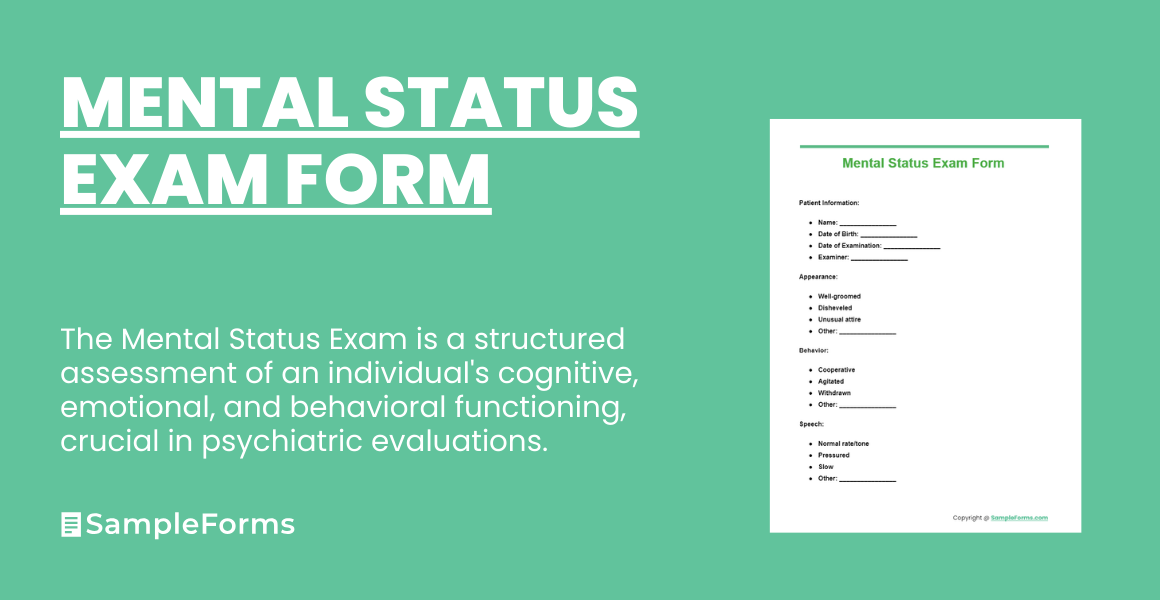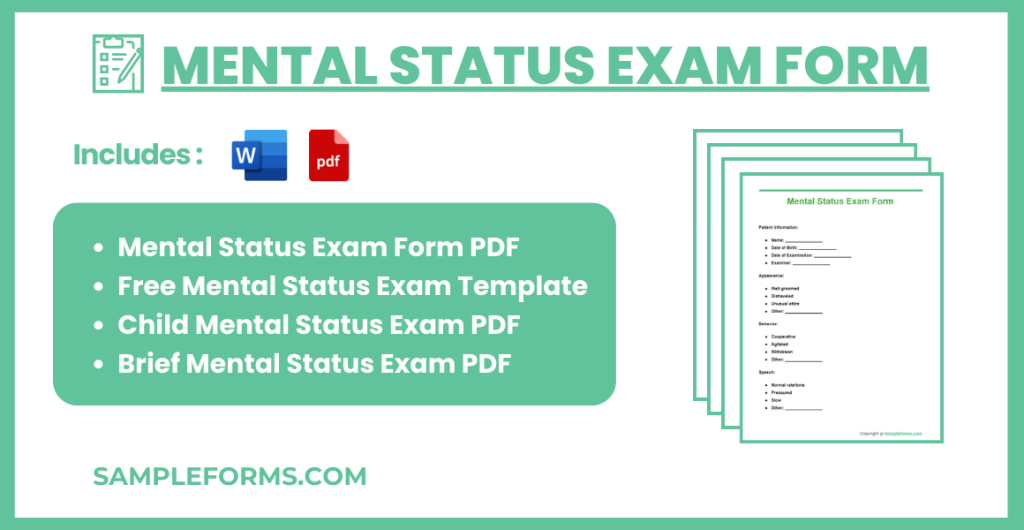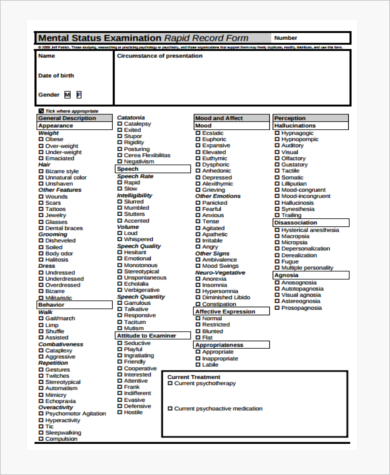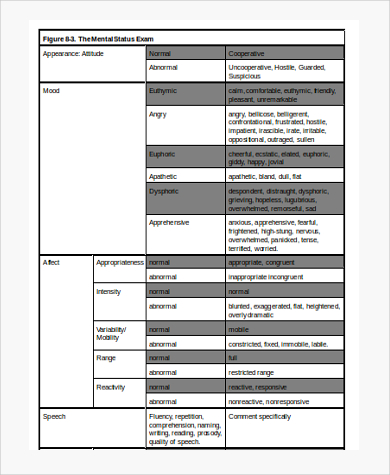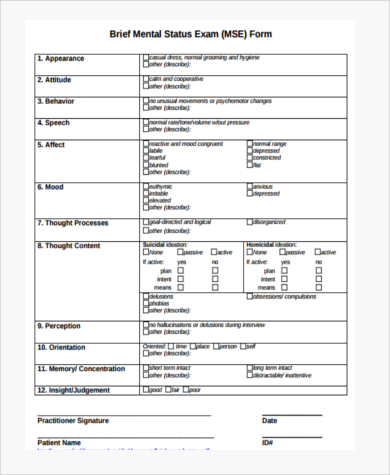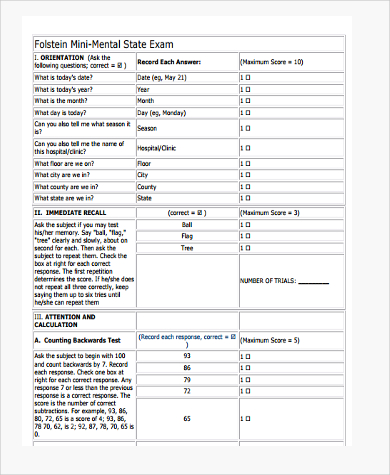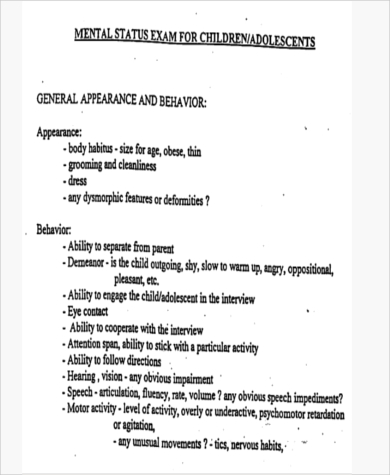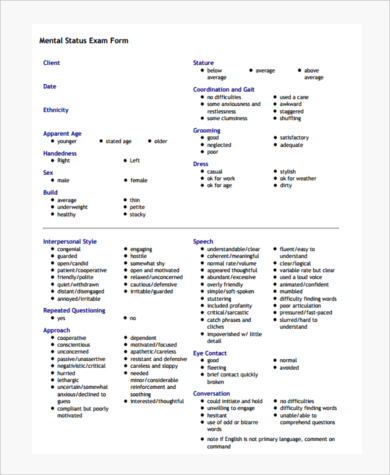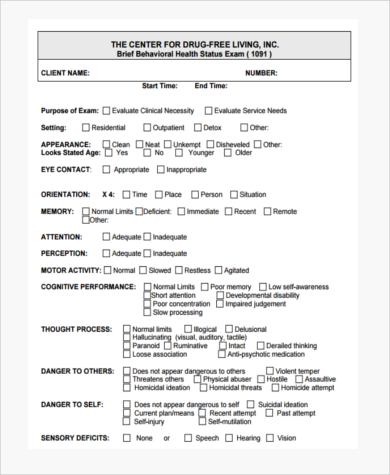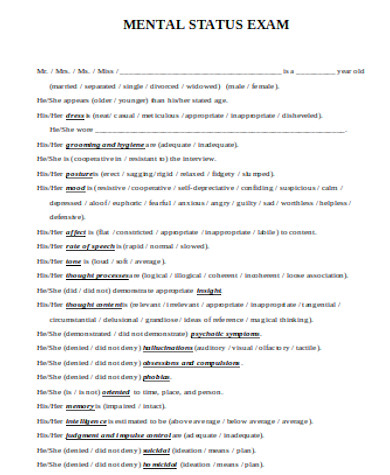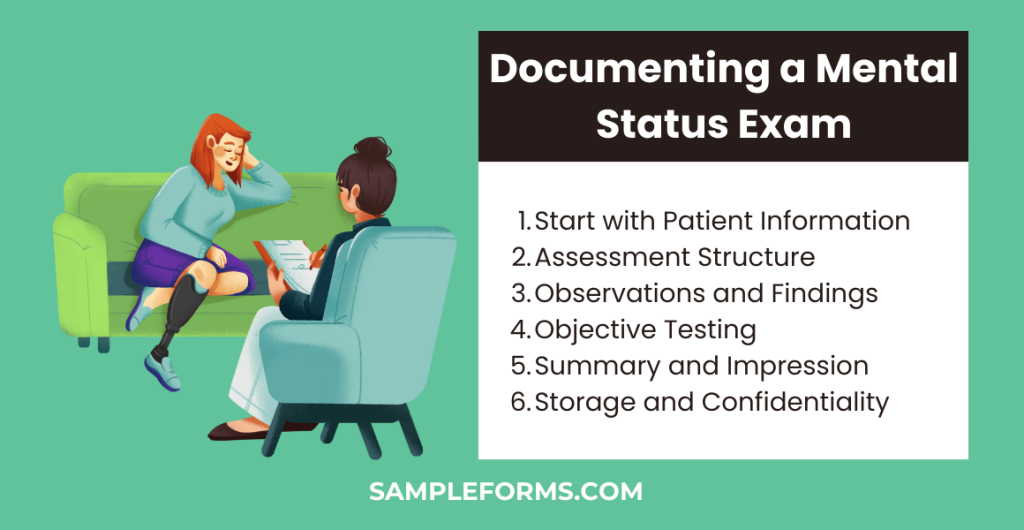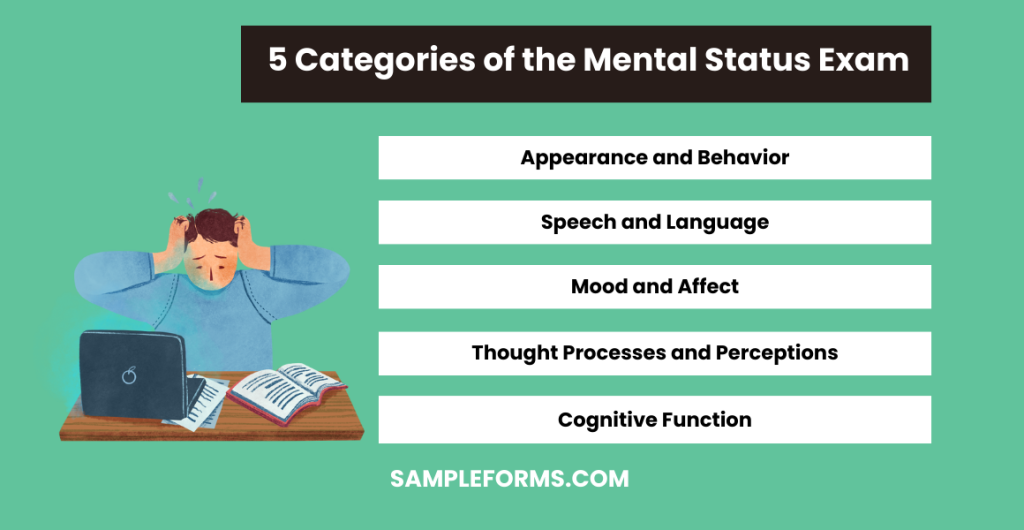Diving into the world of mental health assessments, the Mental Status Exam Form stands as a cornerstone tool for professionals. This guide not only demystifies the process but enriches your understanding with practical examples. Whether you’re drafting a Mental Health Form or conducting an Examination Form, this resource is designed to enhance your diagnostic precision. With every section meticulously explained, from appearance to cognitive functions, you’re equipped to navigate the complexities of mental health evaluations confidently.
Download Mental Status Exam Form bundle
What is a Mental Status Exam Form?
The Mental Status Exam Form is a systematic tool used by healthcare professionals to assess a patient’s cognitive, emotional, and psychological functioning. It’s an integral part of the diagnostic process, providing a snapshot of a patient’s mental health at a given moment. Through observation and a series of questions, the form helps identify symptoms, guide treatment plans, and monitor progress. Essential for comprehensive Medical Examination Forms, it covers areas such as thought processes, mood, behavior, and cognitive abilities, offering a structured approach to mental health evaluation.
Mental Status Exam Format
Patient Information:
- Name:
- Date of Birth:
- Date of Examination:
- Examiner:
1. Appearance
- General Description: (e.g., well-groomed, disheveled)
- Notable Characteristics: (e.g., tattoos, scars)
2. Behavior
- Level of Activity: (e.g., agitated, lethargic)
- Eye Contact: (e.g., normal, avoidant)
- Facial Expressions: (e.g., congruent with mood, flat affect)
3. Speech
- Rate: (e.g., fast, slow, normal)
- Volume: (e.g., loud, soft)
- Articulation: (e.g., clear, slurred)
- Fluency: (e.g., smooth, presence of aphasia)
4. Mood and Affect
- Mood: (patient’s subjective report, e.g., sad, anxious)
- Affect: (observed emotional state, e.g., congruent/incongruent with mood, range)
5. Thought Process
- Flow of Thoughts: (e.g., logical, circumstantial, tangential)
- Continuity of Ideas: (e.g., goal-directed, disorganized)
6. Thought Content
- Delusions: (e.g., none, paranoid, grandiose)
- Hallucinations: (type, e.g., auditory, visual)
- Obsessions/Compulsions: (description)
- Phobias: (specific fears)
- Suicidal/Homicidal Ideation: (presence and details)
7. Cognitive Function
- Orientation: (time, place, person)
- Attention and Concentration: (e.g., able to focus, easily distracted)
- Memory: (immediate, short-term, long-term)
- Abstract Thinking: (ability to understand abstract concepts and metaphors)
- Insight: (understanding of one’s own condition)
- Judgment: (ability to make reasonable decisions)
8. Physical Health
- General Health Status: (e.g., reported illnesses)
- Current Medications: (list medications and dosages)
- Substance Use: (type, frequency, and impact on mental status)
Conclusion and Recommendations:
- Summary of findings
- Recommended next steps or referrals
Examiner’s Signature:
- Name:
- Date:
- Signature:
Mental Status Exam Form PDF, Word, Google Docs
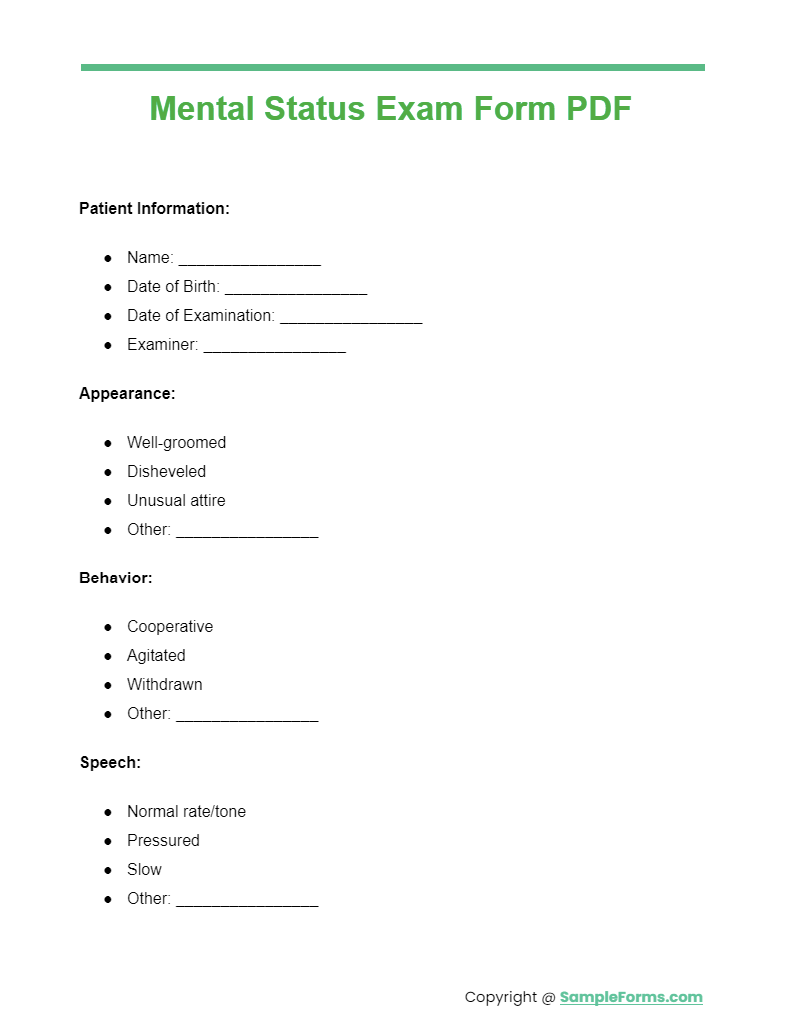
Download our Mental Status Exam Form PDF to conduct comprehensive mental health evaluations. It includes the Mental Health Assessment Form, ensuring a thorough analysis of psychological well-being.
Free Mental Status Exam Template
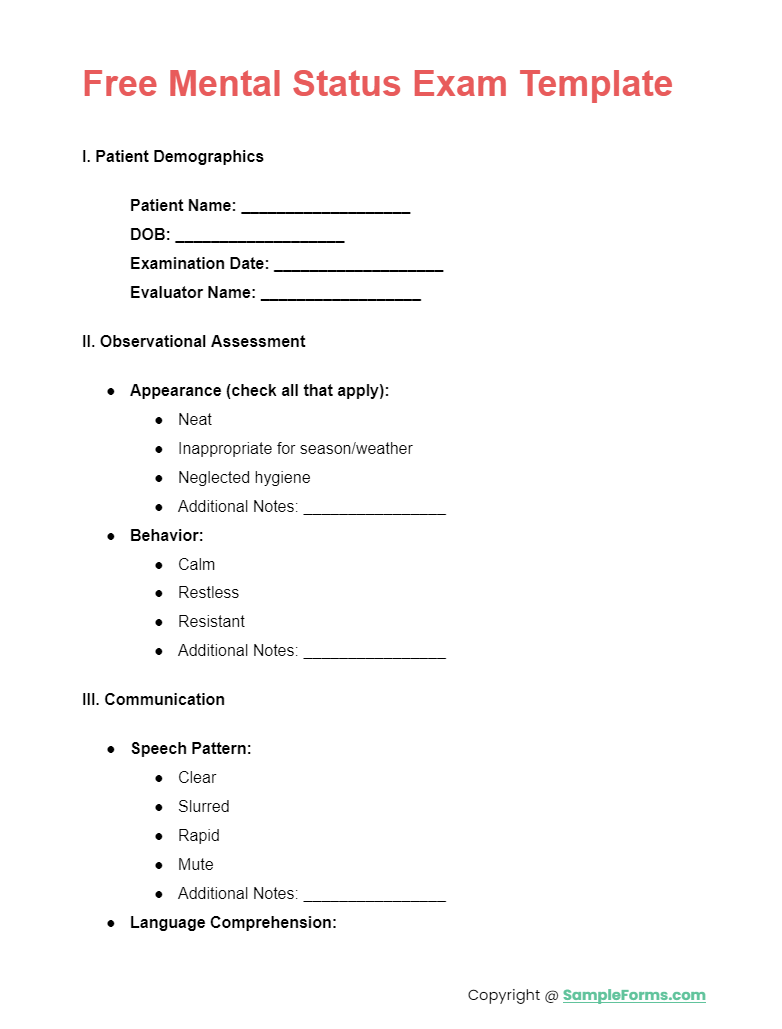
Access our Free Mental Status Exam Template for an easy-to-use framework in assessing patients. This template is complemented by the Mental Health Provider Intake Form, streamlining the initial evaluation process.
Child Mental Status Exam PDF
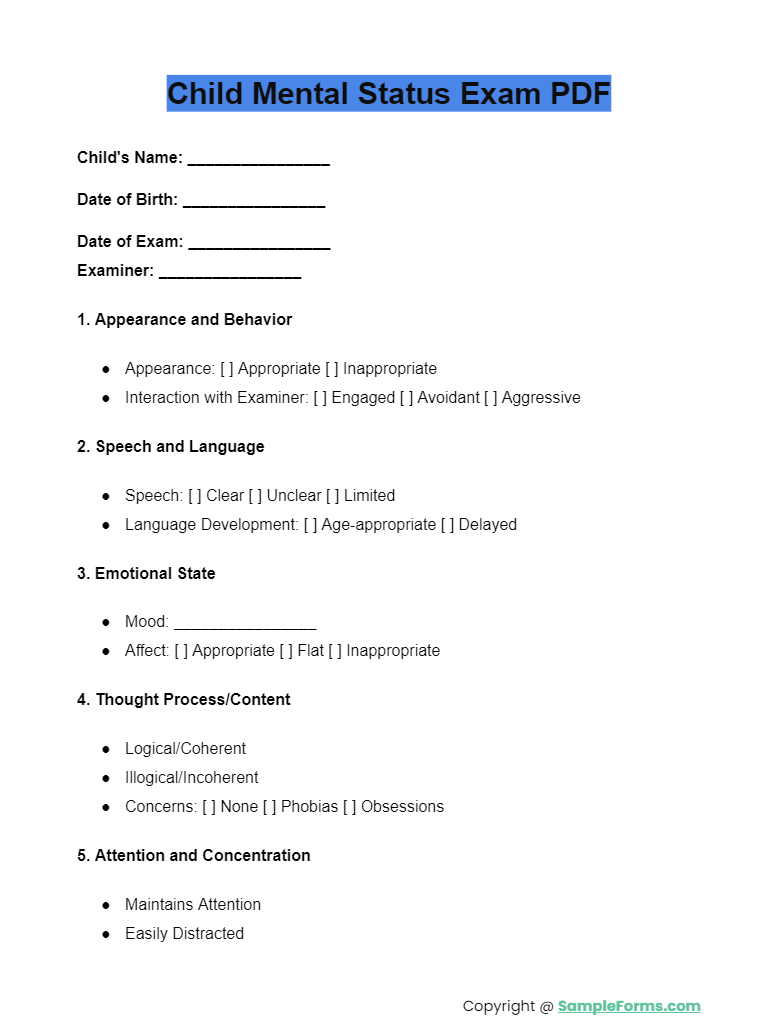
Specialized Child Mental Status Exam PDF caters to the unique needs of pediatric assessments. Integrating elements from the Physical Examination Form, it offers a holistic view of a child’s mental and physical health.
Brief Mental Status Exam PDF
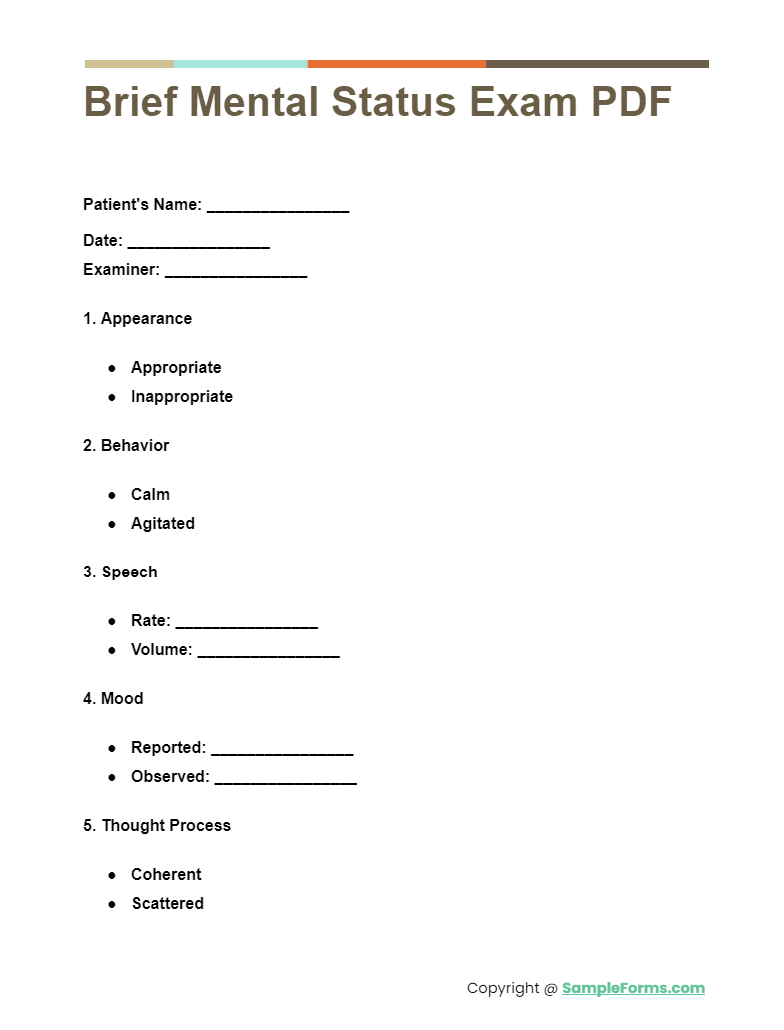
More Mental Status Exam Form Samples
Mental Status Examination Rapid Record Form
Mental Status Exam Sample Form
Short Mental Status Exam Form
Blank Mental Status Exam Form
Mental Status Exam Form for Child
Mental Status Exam Form in PDF
Mental Health Status Exam Form
Psychiatric Mental Status Exam Form
Standard Mental Status Exam Form
How do you Document a Mental Status Exam?
Documenting a Mental Status Exam involves a structured approach:
- Start with Patient Information: Use the Medical Form to record patient details such as name, date, and reason for the evaluation.
- Assessment Structure: Follow the structure of the Mental Status Exam, ensuring each section is thoroughly completed.
- Observations and Findings: Detail observations in areas like appearance, behavior, and cognitive function, utilizing the Physical Assessment Form for comprehensive insights.
- Objective Testing: Include results from objective tests, if any, to support your observations.
- Summary and Impression: Summarize findings and provide a professional impression, indicating the next steps or recommendations.
- Storage and Confidentiality: Ensure the completed exam is stored securely, respecting patient confidentiality and compliance with the Medical Report Form requirements. You also browse our Examination Application Form.
How do you Write a Mental State Exam?
Writing a Mental State Exam requires attention to detail and a systematic approach:
- Introduction: Begin with patient identification details from the Adult Physical Form.
- Appearance and Behavior: Note the patient’s physical appearance, behavior, and interactions during the exam.
- Cognitive Functions: Assess cognitive functions such as memory, attention, and orientation.
- Thought Processes: Evaluate the patient’s thought processes, logic, and coherence.
- Mood and Affect: Describe the patient’s mood and affect, noting any discrepancies between expressed and observed emotions.
- Conclusion: Sum up your findings and suggest further actions, referencing the Physical Health Form for any physical health considerations. You also browse our Health Examination Form.
How to Describe Behavior in Mental Status Exam?
Describing behavior in a Mental Status Exam involves several key observations:
- General Appearance: Note the patient’s hygiene, dress, and physical characteristics using the Employee Physical Form as a reference for normative data.
- Motor Behavior: Observe the patient’s movements, noting any unusual activity or lack thereof.
- Interpersonal Interaction: Comment on how the patient interacts with the examiner and others, if applicable.
- Mood and Affect: Detail the patient’s emotional state and its consistency with the context.
- Attitude Towards the Exam: Note the patient’s willingness, cooperativeness, and engagement with the process.
- Use of Language: Observe clarity, coherence, and any peculiarities in the patient’s speech. You also browse our Physical Certificate Form.
What are the 5 Categories of the Mental Status Exam?
The five categories of the Mental Status Exam include:
- Appearance and Behavior: Assessed through observation upon meeting the patient.
- Speech and Language: Evaluation of speech patterns, fluency, and language use.
- Mood and Affect: Insights into the patient’s emotional state and expressiveness.
- Thought Processes and Perceptions: Analysis of thought organization, content, and any perceptual disturbances.
- Cognitive Function: Tests of memory, attention, orientation, and executive functions, often supported by the Physical Form for a holistic view. You also browse our Physical Therapy Assessment Form.
What are the 4 Types of Mental States?
The four types of mental states commonly assessed are:
- Cognitive State: Focuses on memory, attention, orientation, and problem-solving abilities.
- Emotional State: Assesses mood, affect, and emotional responsiveness.
- Behavioral State: Observes actions, reactions, and general demeanor.
- Perceptual State: Evaluates perceptions, hallucinations, and the patient’s interpretation of reality. You also browse our Physical Exam Form.
The Components of a Mental Status Exam
1. Appearance
Initially, a clinician tries to gauge a patient’s mental state through appearance. A patient’s physical appearance, grooming, the way he is dressed, and his posture are all key components of a person’s mental state based on physical aspects. You also browse our Medical Records Request Form
2. Behavior
The next component of a Mental Status Exam is observing the patient’s behavior. Does he make eye contact? Does he fidget or wring his hands? Do you notice any tremors or abnormal movements? You also browse our Medical Reimbursement Form
3. Speech
Assessing a patient’s speech skills gives more focus on the patient’s ability to produce speech rather than assessing the content of the speech. In order to provide a structured assessment of speech, the clinician will ask patients to name objects or repeat short sentences. By observing a patient’s way of speaking clinicians will be able to observe para-linguistic features like loudness, rhythm, intonation, pitch, articulation, rate, spontaneity, and latency of speech. You also browse our Medical Application Form
Assessing a patient’s language skills will make possible the recognition of medical conditions such as dysathria, neurological conditions like stroke or dementia, and specific language disorders like stuttering or mutism. You also browse our Medical Bill Form
4. Mood and Affect
Mood is a patient’s dominant emotional state which he tells you he feels. Descriptions of a patient’s mood are sometimes indicated with the use of quotation marks to show that those were the patient’s exact description, for example, “Angry, sad, and frustrated.” You also browse our Medical Questionnaire Form
A patient’s affect, on the other hand, is the emotional state that clinicians observe such as euthymic if the patient is in a normal mood, dysphoric if the patient looks depressed or angry, euphoric if the patient is elevated.
Related Links: Medical Information Form
What is the Basic MSE exam?
The Basic MSE (Mental Status Exam) assesses cognitive, emotional, and behavioral functions using structured observations and questions, essential for completing a Medical History Form.
What is the Purpose of a Mental Status Exam?
A Mental Status Examination can be conducted for a lot of reasons, but it is mainly done to provide information that is critical for the diagnosis, the assessment, and the treatment of a disorder. You also browse our Fitness Form.
Who can Perform a Mental Status Exam?
Qualified healthcare professionals, including psychiatrists, psychologists, and general practitioners, trained in mental health assessment can perform an MSE, often documented in a Medical Certification Form.
How Long does a Mental Status Exam Take?
The duration varies, typically ranging from 15 to 60 minutes, depending on the depth of assessment required and any specific concerns noted on the Medical Referral Form.
What Words Describe Affect in Mental Status Exam?
Words like flat, blunted, labile, and euthymic describe affect, reflecting the patient’s emotional state and any fluctuations, as noted in their Medical Clearance Form.
What Words are used to Describe Mental Status?
Terms such as alert, confused, disoriented, and agitated are used to describe mental status, providing insights into cognitive and emotional states for the Medical Release Form.
Which Comes first Thoughts or Emotions?
The debate varies, but many theories suggest emotions can trigger thoughts, and vice versa, influencing how a patient’s condition is described in a Dental Medical Clearance Form.
Related Posts
Sample Speech Evaluation Forms - 9+ Free Documents in Word, PDF
Sample Audit Report Forms - 8+ Free Documents in Word, PDF
Printable Medical Forms
Functional Behavior Assessment Form - 8+ Free Documents in Word ...
15+ Sample Certificate of Service Forms Sample Forms
Sample Employment Questionnaire Forms - 8+ Free Documents in ...
8+ Counseling Intake Forms - Free Sample, Example Format ...
22+ Nursing Assessment Form Samples
8+ Fitness Assessment Form Samples - Free Sample, Example ...
39+ Free Health Assessment Forms
Sample Fitness Assessment Forms - 9+ Free Documents in PDF
Sample Physical Assessment Forms - 8+ Free Documents in PDF ...
Sample Physical Examination Form - 9+ Free Documents in PDF
Sample Psychosocial Assessment Form - 8+ Free Documents in ...
7+ Sample Dental Examination Forms
